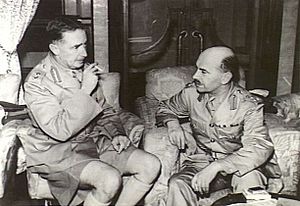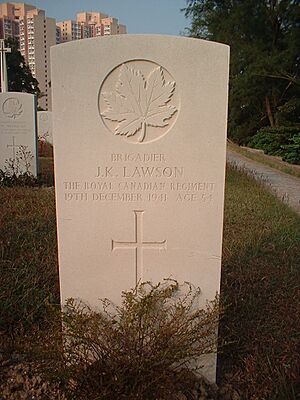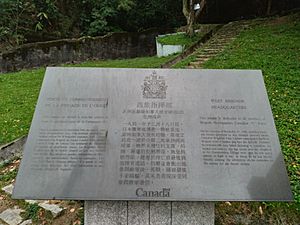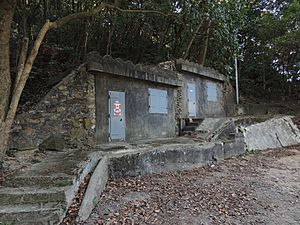John K. Lawson facts for kids
Quick facts for kids
John Kelburne Lawson
|
|
|---|---|

Brigadier John K. Lawson (right) with General Christopher Maltby
|
|
| Born | 27 December 1886 Hull, England |
| Died | 19 December 1941 (aged 54) British Hong Kong |
| Buried |
Sai Wan War Cemetery, Chai Wan
|
| Allegiance | Canada |
| Service/ |
Canadian Army |
| Years of service | 1914–1941 |
| Rank | Brigadier |
| Commands held | C Force |
| Battles/wars | World War I |
| Awards | Croix de Guerre |

John Kelburne Lawson (born December 27, 1886 – died December 19, 1941) was a brave Canadian military officer. He led the West Brigade during the important Battle of Hong Kong. He was the highest-ranking Canadian soldier to be killed in action during World War II.
Contents
Early Life and Military Start
John Kelburne Lawson was born in Kingston upon Hull, England. In 1914, he moved to Edmonton, Canada. There, he worked as a clerk for the Hudson's Bay Company.
When World War I began, Lawson joined the Canadian army. He was part of the Canadian Expeditionary Force (CEF). This was the main group of Canadian soldiers who fought overseas. He started as a private soldier in 1914. By the end of the war, he had become a captain.
Awards for Bravery
Lawson fought in major battles like the Battle of Passchendaele and the Battle of the Somme. He was recognized for his courage twice. He also received the French award called the Croix de Guerre. This award is given for bravery in battle.
Between the World Wars
After World War I, Lawson stayed in the military. He worked in different places across Canada. He also studied at a special staff college in Quetta. In 1930, he worked at the War Office in London, England.
When World War II started, Lawson was in Ottawa. He was in charge of military training. Later, he was given command of Canadian troops. These included the Royal Rifles of Canada and The Winnipeg Grenadiers. These soldiers arrived in Hong Kong on November 16, 1941. They were there to help defend the British area before the Battle of Hong Kong began.
The Battle of Hong Kong

The Battle of Hong Kong took place from December 8 to December 25, 1941. On December 11, the defending forces moved to Hong Kong Island. General Christopher Maltby divided the island's defense into two parts. Lawson was put in charge of the West Brigade. His brigade included Canadian, British, and Indian soldiers.
Final Stand
On December 18, 1941, Japanese forces landed on Hong Kong Island. Their goal was to split the defenders in two. There was very fierce fighting. By December 19, Japanese soldiers had surrounded Lawson's headquarters. At about 10:00 AM, Lawson sent a radio message. He said he was "going outside to fight his way out." He left his shelter with a small group of officers. He was killed right away by Japanese machine gun fire.
Honoring a Hero
When the Japanese found Lawson's body, they buried him nearby. They did this to show respect for his bravery. A chaplain was allowed to take Lawson's identification bracelet. He kept it safe for four years as a prisoner of war. Later, he returned it to Lawson's family in Canada.
After the war, Lawson was reburied at the Sai Wan War Cemetery. In 2005, the Canadian government placed a memorial plate at the site. This plate honors Lawson's courage and sacrifice.
Personal Life
John Kelburne Lawson was married to Augusta Hawkesworth Wilson in 1930. They had two sons, Arthur John and Michael Ivan. Lawson's family later gave his medals to the Royal Canadian Military Institute.
See also


